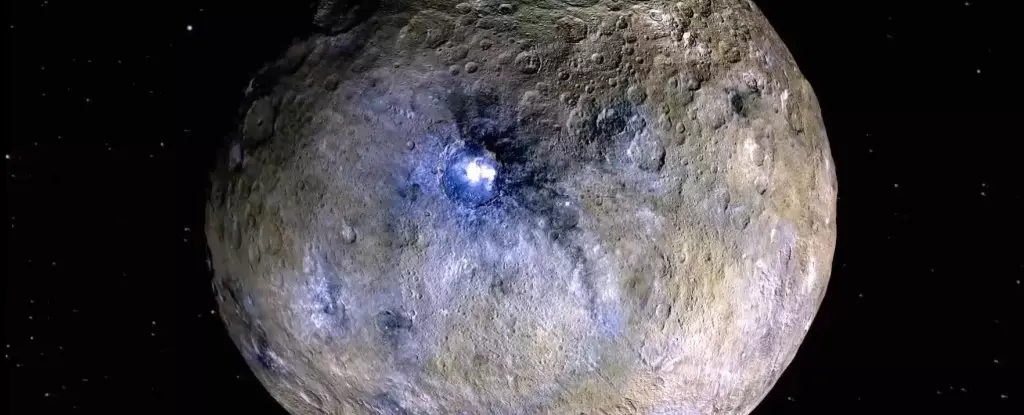Ceres has intrigued scientists and space enthusiasts since its discovery in 1801. Located in the asteroid belt between Mars and Jupiter, this dwarf planet is remarkable for its size, being the largest object in its region. While traditionally grouped with asteroids, Ceres stands out due to its spherical shape and classification as a dwarf planet, making it a unique entity in our solar system. Recent studies have revealed that Ceres may be hiding a more substantial secret beneath its surface: an impressive amount of water ice.
For years, scientists have speculated about the composition of Ceres. Its enigmatic bright spots hint at ice presence, potentially signaling ice volcanoes that have etched the surface. The earlier estimates suggested that Ceres contained no more than 30% water ice, primarily driven by the surface’s well-preserved craters—features that would ordinarily be smoothened over time if the surface were significantly icy. Yet, recent insights from NASA’s Dawn spacecraft challenge our previous assumptions about Ceres’ icy crust.
Planetary geophysicist Mike Sori from Purdue University emphasized that the prevalent icy material can maintain its structure over time, a conclusion drawn from extensive computer simulations which integrate elements of geology. These simulations have demonstrated that even a mere influx of rocky material into the ice mix can stiffen the crust against deformation, allowing Ceres to keep its clearly defined craters for potentially billions of years. This astonishing twist suggests that the dwarf planet’s crust may hold more than 90% water ice, a prospect that shifts our understanding of Ceres as a frozen world.
The complexities of Ceres have led scientists to reevaluate how ice can behave in extraterrestrial environments. In previous models, it was assumed that icy surfaces would deform similarly to glaciers on Earth or thick honey, yielding a smoother landscape over time. However, Sori and his team have uncovered that under cooler conditions found on Ceres, ice could retain its configuration remarkably well if mixed with solid-rock impurities.
Planetary scientist Ian Pamerleau, leading the simulations, asserted that the incorporation of non-icy materials contributes positively to the mechanical integrity of the ice crust. This solid-state behavior means that craters, which would typically relax and lose definition on a fully icy surface, instead remain sharply defined under the right conditions. Thus, the hypothesis stands that a layered crust exists—one that is rich in water ice at its surface while gradually decreasing in ice content deeper down.
Significantly, if Ceres truly harbored a substantial amount of water ice beneath its surface, it would echo qualities seen on other celestial bodies, particularly those categorized as ocean worlds like Jupiter’s moon Europa and Saturn’s moon Enceladus. These moons are believed to retain liquid water beneath their icy shells, sustained by internal heat generated by gravitational interactions. However, Ceres’s situation is distinct; this dwarf planet does not orbit a massive planet, meaning it lacks the same tidal forces to keep its interior warm. The implications are profound—a frozen landscape that once might have functioned as an ocean world is now encapsulated in ice.
Sori theorizes that Ceres may have once been an oceanic body but remained muddied and slushy underneath its icy shell. The transition to a frozen state could have occurred as the original ocean solidified over time. This recontextualization modifies our outlook on what constitutes ocean worlds, suggesting they can look vastly different than previously envisioned.
With Ceres’ newfound characterization as a likely ice-rich body, scientists are excited by the potential for further exploration. The Ceres mission by NASA’s Dawn spacecraft has yielded valuable data, but the dwarf planet now presents opportunities for more focused investigations in the future. Given its proximity to Earth, the prospects of sending a follow-up mission could unlock secrets not only about Ceres but also about other ocean-bearing moons scattered across our solar system.
Sori sums up the excitement succinctly: Ceres stands as a unique vantage point, potentially allowing researchers to draw comparisons with other icy worlds. The revelations about Ceres emphasize that our understanding of the cosmos is still unfolding and that even familiar celestial objects can present new revelations about the processes that have shaped them.
Ceres appears to be far more than a frozen remnant of our solar system’s early days; it mirrors complex geological histories and broadens our understanding of planetary science, inviting deeper exploration into its ice-capped shell.


Leave a Reply